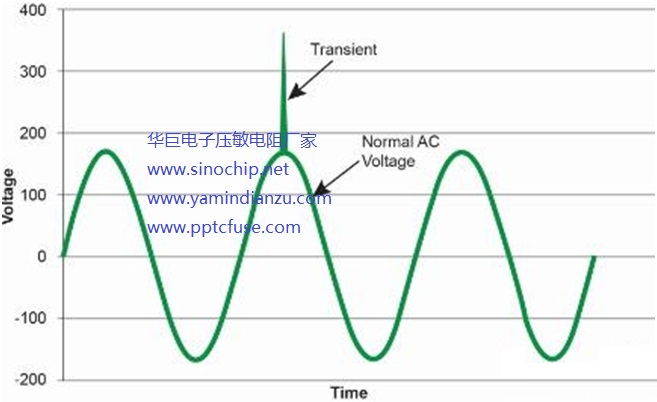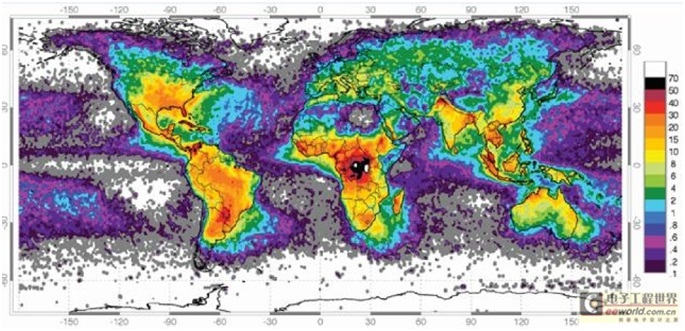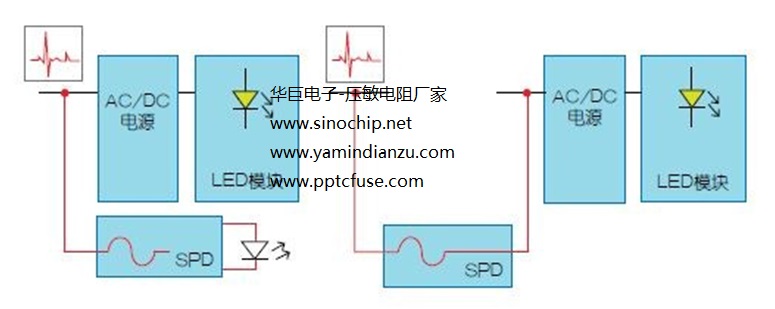For outdoor LED lighting, a considerable threat is a transient surge event that occurs in the AC power line, which may cause damage to the lamp. An LED lamp contains a power conversion device (AC/DC), a driver chip for the LED, and a heat sink for thermal control and optics to optimize light quality. An LED fixture that is directly connected to an AC power source (such as 120/220VAC) may be damaged due to a short circuit and an overload condition caused by a failure of the lamp's internal components or circuitry. In addition, lightning surges or load-switching transients that occur outside the bulb can cause voltage spikes or ring-like waves that cause stress on the components and eventually damage, causing the bulb to fail. Given the value proposition of LED bulbs is not only to reduce energy consumption, but also to have a longer lifetime, it is critical to consider transient voltage protection in eliminating field failures caused by electrical environments.
Indirect lightning induced surge
Due to the opening and closing of nearby electrical equipment, overvoltage transient surges may occur on the AC power line. Nearby lightning strikes can also create transient surges on AC power lines, especially in outdoor environments.

Figure 1: Transient surges in AC power lines.
At the moment of a lightning strike, the level of electrostatic discharge from the cloud to the ground typically reaches millions of volts. Lightning strikes that occur several miles away can induce up to thousands of volts of induced voltage on current-carrying copper lines (eg, underground cables for street lights). These indirect impacts are characterized by specific waveforms that typically contain more than 1,000 A2s of energy.
About 70% of the lightning strikes occur in the land areas of the tropics, which is where most thunderstorms occur. African countries have experienced the most severe and long-lasting lightning strikes in history. Lightning strikes occur most frequently in the small village of Kifka, in the eastern part of the Democratic Republic of the Congo, at an altitude of approximately 975 meters. On average, 158 lightning strikes per square kilometre occur in the area each year. A large area around this place is also seriously affected because the induced surge caused by lightning strokes increases the chances of outdoor LED lighting damage.
According to NASA's research on lightning frequency around the world, Central and South America, Africa, South Asia, and Southeast Asia also have lightning flashes that are similar to those of the United States; therefore, in the United States, we propose that the equivalent surge immunity should be 5 kA. Between 10kA. For other areas where lightning frequency is low, such as Europe, East Asia, and Australia, a lower surge immunity of 3kA to 5kA can be considered.
This type of indirect lightning energy can adversely affect outdoor LED lighting fixtures during stormy weather. Light fixtures are easily damaged in both differential and common mode conditions:
Differential mode: High voltage/current transients between the phase and neutral terminals of the lamp or the phase and phase terminals may damage components in the power supply unit or the LED module board.
â— Common mode: High voltage/current transients between the phase and ground lines or neutral conductors and ground may penetrate the safety insulation in the power supply unit or LED module board, including LED heatsink insulation.
The test waveform is a combination of 1.2 x 50μs open circuit voltage and 8 x 20μs short circuit current waveform. To perform this test, the specified peak current is calibrated on the surge generator by shorting the output to ground before connecting to the fixture.

Figure 2: Combined wave open circuit voltage.

Figure 3: Combined wave short-circuit voltage.
Lightning frequencies around the world - unit: number of lightnings per square kilometer/year - (NASA Global Hydrological Resource Center).

Figure 4 Lightning frequencies around the world - units: number of lightnings/square kilometer/year - (NASA GHRC).
Technology to deal with induced surge events
The way to protect outdoor LED lighting from induced surge damage is to block high voltage/current transients from entering the lighting fixture. Therefore, a surge protector (SPD) can be used in outdoor LED lighting applications to suppress the surge energy and minimize the surge impact on the lighting equipment.
For SPDs, a variety of overvoltage protection devices are available, including metal oxide varistors (MOVs), gas discharge tubes (GDTs), and transient voltage suppression (TVS) diodes. These components are placed between AC power lines, which typically have high impedance, and become low impedance when a high voltage is detected. In low-impedance states, these components can transfer surge energy back to the AC power line, returning to a high-impedance state after a surge event. In the existing technology, MOV is preferred because of its high surge energy processing capability and fast response to transient voltage, and it is also widely used in SPD protection of distribution boards. Therefore, MOV is the most suitable technology for surge protection devices in outdoor LED lighting applications.
The incorporation of a powerful surge suppression circuit in an outdoor fixture can eliminate the damage caused by surge energy, thereby increasing the reliability of the lighting equipment, minimizing maintenance and increasing the service life. A surge protection device that can suppress excessive surges to lower voltage levels is the best way to protect LED lighting fixtures.

Figure 5: LED street light protection scheme.
Huaju Electronics Over-temperature Over-voltage Over-voltage Protection MOV Protection SPD Safety
Using a high-voltage self-healing fuse with overcurrent protection and a varistor compound, the varistor uses a varistor with a varistor voltage of 390V. The varistor voltage can be clamped at 390V, which is better than the 471K clamp. Low voltage. The self-resetting fuse can limit the current protection varistor and the following devices. When the circuit works normally, the lightning protection module normally flows the current. If the protected device fails, short circuit, over current, or overload, the composite self-recovering fuse will The action will show a high-impedance state, cut off the current protection device, remove the thermistor from the restoration of the fuse to return to normal, the circuit can work normally, when the power supply appears a transient spike, the varistor action turns on the voltage clamped in the 390V protection behind the device When the power supply is overvoltaged for a long time, the varistor acts to turn on. At this time, the varistor's action clamps the voltage to 390V on the one hand so that the device can operate normally. On the other hand, the varistor conducts through the varistor. Since the current of the self-healing fuse is increased, the self-resetting fuse is caused to act. At this time, the self-resetting fuse limits the current. Since the value of the self-healing fuse increases, a part of the voltage is applied to both ends of the fuse, and the clamping of the rear varistor is added. The operating voltage of the device can be stabilized at the required operating voltage of the device The self-healing fuse in lightning protection can limit the excessive lightning current to damage the varistor due to its own resistance, and can also isolate the lightning high voltage from the varistor outside the circuit so as to effectively protect the varistor and Follow-up equipment
Metal Oxide Varistor (MOV) technology is not only inexpensive, but also a very effective technique for suppressing transients in power supplies. In many other applications, this technique is equally effective, such as a Surge Protector (SPD) module that is usually placed in front of the LED driver.
After a large surge or multiple small surges, MOV performance will gradually degrade. This degradation causes the leakage current of the metal oxide varistor to increase, which in turn causes the temperature of the MOV to increase, even under normal conditions of 120VAC/240VAC operating voltage. A PTC thermistor self-healing fuse adjacent to MOV can be used to detect the temperature increase when the metal oxide varistor is continuously degraded to the end of life; at this time, the PTC resettable fuse will become a high-impedance state. The degraded varistor is removed from the circuit to prevent catastrophic failure.

Figure 6: The thermistor resets the fuse to prevent the performance degradation of the MOV from failing.
WMZ13A-2W-265Vac Suitable for LED lighting 2W and below electronic products lightning protection, over-voltage and over-temperature protection
WMZ13A-3W-265Vac Suitable for LED lighting 3W and below electronic products lightning protection, over-voltage and over-temperature protection
WMZ13A-5W-265Vac Suitable for LED lighting 5W and below electronic products lightning protection, over-voltage and over-temperature protection
WMZ13A-6W-265Vac Suitable for LED lighting 6W and below electronic products lightning protection, over-voltage and over-temperature protection
WMZ13A-7W-265Vac Suitable for LED lighting 7W and below electronic products lightning protection, over-voltage and over-temperature protection
WMZ13A-10W-265Vac Suitable for LED lighting 10W and below electronic products lightning protection, over-voltage and over-temperature protection
WMZ13A-15W-265Vac Suitable for LED lighting 15W and below electronic products lightning protection, over-voltage and over-temperature protection
WMZ13A-20W-265Vac Suitable for LED lighting 20W and below electronic products lightning protection, over-voltage and over-temperature protection
WMZ13A-26W-265Vac Suitable for LED lighting 26W and below electronic products lightning protection, over-voltage and over-temperature protection
WMZ13A-40W-265Vac Suitable for LED lighting 40W and below electronic products lightning protection, over-voltage and over-temperature protection
WMZ13A-90W-265Vac Suitable for LED lighting power 90W and below electronic products lightning protection, over-voltage and over-temperature protection
WMZ13A-120W-230Vac Suitable for LED lighting power 120W and below electronic products lightning protection, over-voltage and over-temperature protection
WMZ13A-150W-256Vac Suitable for LED lighting 150W and below electronic products lightning protection, over-voltage and over-temperature protection
WMZ13A-200W-265Vac Suitable for LED lighting power 200W and below electronic products lightning protection, over-voltage and over-temperature protection
The MOV is designed to clamp fast overvoltage transients in microseconds. However, in addition to the short-term transients, the MOVs in the SPD module are also affected by temporary overvoltage conditions due to missing zero lines or improper wiring during installation. These conditions can cause serious pressure on MOVs, causing them to go into a state of uncontrolled heat dissipation; in turn, this will lead to overheating, smoking, and even fire. The SPD safety standards UL 1449 and IEC 61643-11 define specific abnormal conditions that must be tested on the device to ensure SPD safety. In a reliable design, a thermal circuit breaker is added inside the surge protector to protect the MOV from heat loss.

Figure 7: AC overcurrent event.
End-of-life/replacement indicator function for SPD
Thermal circuit breakers can be used to remove metal oxide varistors from the AC circuit when the MOV becomes overheated due to temporary overvoltages or excessive leakage currents. The SPD therefore stops its surge suppression function. Therefore, consider designing an appropriate indication function so that maintenance personnel can know that the SPD is not working and needs to be replaced.
Lighting designers can choose from two major types of SPD module configurations based on their maintenance and repair strategy. These are the surge protection components in parallel and in series.

Figure 8: Parallel and series connections.
â— Parallel connection: The SPD module is connected in parallel with the load. When an end-of-life SPD module is disconnected from the power supply, the AC/DC power supply unit remains powered. The lighting is still working, but it has lost the protection against the next surge of power devices and LED modules. In a parallel SPD module, the replacement indicator can be used by using a small LED that can indicate the state of the SPD module to the maintenance technician. You can choose to use a green LED to indicate that the SPD module is online, or use a red LED to indicate that the SPD module is offline. Alternatively, the need to replace the SPD module may be remotely displayed in the lighting management center where the SPD module end-of-life indication line is connected to a networked intelligent lighting system, rather than having LED indicators installed on each luminaire.
â— Serial connection: The SPD module is connected in series with the load. When the SPD module with end of life is disconnected from the power supply, the SPD module will also be extinguished. Lamp power failure can be used as an indication of call maintenance. The disconnected SPD module not only extinguishes the illumination as an indication of replacement, but also isolates the AC/DC power supply device from subsequent surge shocks. The prevailing preference for this configuration is growing rapidly because lighting fixtures are still protected during the SPD module waiting to be replaced. Compared to replacing an entire luminaire with parallel surge protector modules, replacing only the SPD module in the series is much less expensive.
to sum up
The high efficiency and energy saving brought by LED technology has enhanced the value of outdoor lighting. In order for LED lighting equipment to achieve its expected life, surge protection modules should be added to outdoor LED lighting to prevent early failure due to lightning surge events and other power line surges. The surge protection module installed on the front of the LED power supply device provides effective protection for the lighting system. However, it may be subject to temporary overvoltage threats and fatigue due to multiple surge events. The thermal circuit breaker placed in the surge protection module increases the overall safety of the module and enables the module to meet UL 1449 and IEC 61643-11 certification standards.
When the surge protection module reaches its end of life, the SPD module in series provides the simplest way to replace the indicator, that is, the lamp is turned off by disconnecting the lamp from the power supply. The parallel SPD module provides a connection to the light emitting diodes to prompt whether the module is online.
Our reception sofa waiting chair is suitable for receptions, lounges, meetings, and other rooms. It is made of durable PU leather, leather color are changeable. Wooden and metal frame makes this beauty chair solid.
Colors can be optional, color charts for reference. Beauty Waiting Chair is suitable for each people, comfortable and attractive look. Comes with environment friendly technology, the reception chair is an affordable choice for you.
Beauty Waiting Chair
Salon Waiting Chairs,Customer Waiting Chairs,Barber Shop Waiting Chairs,Office Reception Chairs
TOM SPA BEAUTY SALON EQUIPMENT CO.,LTD , https://www.tomspabeauty.com